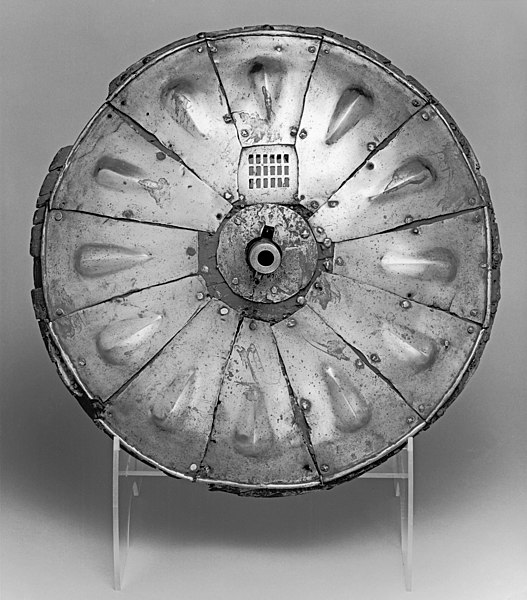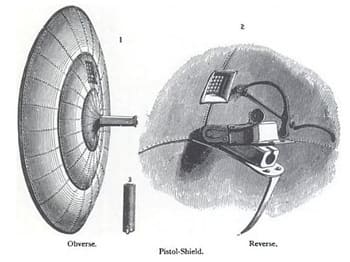
“The best defence is a good offence,” they say. Just as well. Numbers keep dropping for my high school team’s roster – too many kids just not tough enough to make it through spring training. Pretty weak stuff, if you ask me. Oklahoma drills in hailstorms build character, if you ask me! At any rate, with a few of the wimpy kids fucking off to play video games and do calculus and whatever, the remainder of my defence needs to step up and play both ways for the coming season. Now THAT’s what I’m talking about! You really wanna be a weapon out there on the field? You really wanna make us all proud? Go out there and do it all. That’s why I applaud this week’s invention – it’s got heart and character to spare!
THE GUN SHIELD

Purpose built: A Renaissance-era portable weapon with a built-in defence mechanism
Years used: c. Mid-16th century
What is it? In 1544, an Italian gunsmith from the city of Ravenna, by the name of Giovanni Battista, wrote a letter to the famous English king Henry VIII, proposing a bold new innovation in the fledgling world of European firearms. In his letter, he outlined the concept of a “gun shield”; in the 16th century, this meant a traditional match-lock pistol, surrounded by a thick metal shield on all sides. Capping off the design was a small observation port in the middle , just immediately above the barrel, in order for the user to aim the weapon.

Why didn’t it work? Was it a good idea? Honestly, yeah. The issue, really, was just that it was ahead of its time. A few notable issues with this Reformation-era Italian version:
- It was made out of solid iron making it ridiculously heavy. As a handheld weapon, it would have been basically useless due to the arm strength required to steady the gun when aiming and firing.
- The weapon was designed primarily as an offensive one; the matchlock pistols were powerful firearms, but not terribly accurate – even in their lightest forms.
- While the gun part of the shield was superior to many contemporary firearms due to the fact that it could be loaded from the rear, as opposed to from the muzzle, which would have been more stupid… the reality of match-lock and flint-lock firearms still necessitated that it needed to be regularly cleaned after every few shots… elsewise stray, gummed-up gunpowder would end up making the thing blow up in your face.
- I’m not certain that the shield’s design would have made it effective at actually shielding the user from anything – while the guns could have likely pierced their target’s plate armor at a close-to-medium range, it’s quite likely that the shield would have been at a similar disadvantage – therefore not actually giving the user an upper hand, in the end.
- The Italian versions are smaller and lighter than the English-constructed versions, which are said to have been intended for use on a ship similar to side-mounted cannons. Once again, if the shield part is not particularly effective, and the gun itself is both heavy and inaccurate… ultimately, what’s the purpose of this weapon – even if it does look cool?
What could make it better?
What this weapon needs to be useful is lighter and stronger shield technology, as well as a lighter and more accurate gun in the middle. Fortunately, both these things have happened in the preceding centuries! Gun shields have gone in and out of fashion over the years, but currently exist in several forms – most notably as the Transparent Armor Gun Shield (TAGS) that is currently mounted on the top of a variety of US Armed Forces vehicles, including tanks, LAVs, and more. Using transparent bullet-proof plastic shielding, it’s far lighter than the ancient Italian variety, and offers far better sightlines to the user as well. The Israeli Defence Force also uses similar equipment on many of their armored vehicles. A few other handheld versions exist for tactical usage, though they are not nearly as prevalent as the larger versions mounted on vehicles.

Information from this article taken from here, here, here, here, here and here. Banner image by The Maestro.
Would this have helped the Italians in North Africa?
If a gunshield was good enough for American Gladiators it’s good enough for me.
“The Italian versions are smaller and lighter than the English-constructed versions”
Some things never change…

Wait, did any of the underwear you reviewed come with an insertable kevlar “gun shield”?
Technically a jock strap could be considered a gun shield.
https://www.youtube.com/watch?v=SO_zezpjnUQ